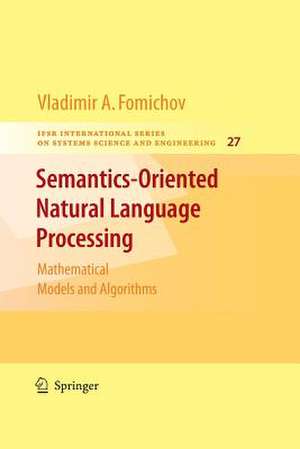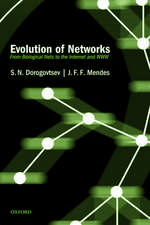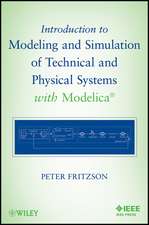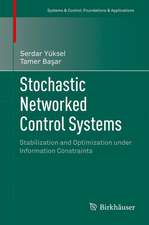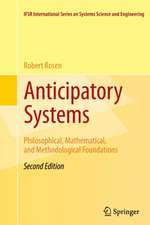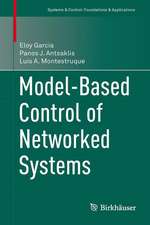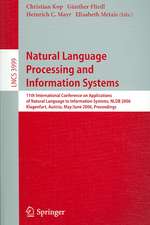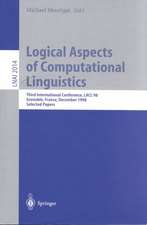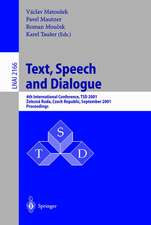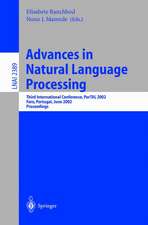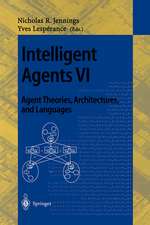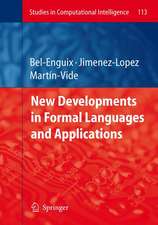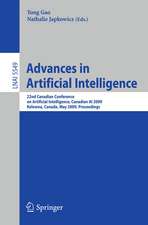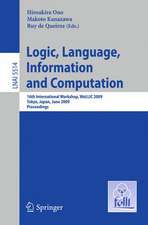Semantics-Oriented Natural Language Processing: Mathematical Models and Algorithms: IFSR International Series in Systems Science and Systems Engineering, cartea 27
Autor Vladimir Fomichov A.en Limba Engleză Paperback – 20 noi 2014
| Toate formatele și edițiile | Preț | Express |
|---|---|---|
| Paperback (1) | 391.40 lei 6-8 săpt. | |
| Springer – 20 noi 2014 | 391.40 lei 6-8 săpt. | |
| Hardback (1) | 398.92 lei 6-8 săpt. | |
| Springer – 4 dec 2009 | 398.92 lei 6-8 săpt. |
Din seria IFSR International Series in Systems Science and Systems Engineering
- 18%
 Preț: 955.70 lei
Preț: 955.70 lei - 18%
 Preț: 951.91 lei
Preț: 951.91 lei - 18%
 Preț: 1391.21 lei
Preț: 1391.21 lei - 18%
 Preț: 955.56 lei
Preț: 955.56 lei -
 Preț: 387.58 lei
Preț: 387.58 lei - 20%
 Preț: 994.73 lei
Preț: 994.73 lei - 18%
 Preț: 1132.33 lei
Preț: 1132.33 lei - 15%
 Preț: 637.59 lei
Preț: 637.59 lei - 15%
 Preț: 640.24 lei
Preț: 640.24 lei - 20%
 Preț: 989.79 lei
Preț: 989.79 lei - 18%
 Preț: 947.67 lei
Preț: 947.67 lei - 18%
 Preț: 953.03 lei
Preț: 953.03 lei - 15%
 Preț: 643.84 lei
Preț: 643.84 lei -
 Preț: 386.61 lei
Preț: 386.61 lei - 18%
 Preț: 1109.92 lei
Preț: 1109.92 lei - 20%
 Preț: 501.43 lei
Preț: 501.43 lei - 18%
 Preț: 1116.26 lei
Preț: 1116.26 lei -
 Preț: 399.29 lei
Preț: 399.29 lei - 20%
 Preț: 644.48 lei
Preț: 644.48 lei - 15%
 Preț: 646.62 lei
Preț: 646.62 lei - 19%
 Preț: 447.27 lei
Preț: 447.27 lei -
 Preț: 388.52 lei
Preț: 388.52 lei - 18%
 Preț: 792.03 lei
Preț: 792.03 lei - 15%
 Preț: 648.42 lei
Preț: 648.42 lei - 18%
 Preț: 786.36 lei
Preț: 786.36 lei -
 Preț: 520.08 lei
Preț: 520.08 lei - 15%
 Preț: 643.00 lei
Preț: 643.00 lei
Preț: 391.40 lei
Nou
Puncte Express: 587
Preț estimativ în valută:
74.90€ • 81.33$ • 62.92£
74.90€ • 81.33$ • 62.92£
Carte tipărită la comandă
Livrare economică 22 aprilie-06 mai
Preluare comenzi: 021 569.72.76
Specificații
ISBN-13: 9781489982803
ISBN-10: 1489982809
Pagini: 352
Ilustrații: XXIII, 328 p.
Dimensiuni: 155 x 235 x 18 mm
Greutate: 0.49 kg
Ediția:2010
Editura: Springer
Colecția Springer
Seria IFSR International Series in Systems Science and Systems Engineering
Locul publicării:New York, NY, United States
ISBN-10: 1489982809
Pagini: 352
Ilustrații: XXIII, 328 p.
Dimensiuni: 155 x 235 x 18 mm
Greutate: 0.49 kg
Ediția:2010
Editura: Springer
Colecția Springer
Seria IFSR International Series in Systems Science and Systems Engineering
Locul publicării:New York, NY, United States
Public țintă
ResearchCuprins
I A Comprehensive Mathematical Framework for the Development of Semantic Technologies.- Mathematical Models for Designing Natural Language Processing Systems as a New Field of Studies for Systems Science.- to Integral Formal Semantics of Natural Language.- A Mathematical Model for Describing a System of Primary Units of Conceptual Level Used by Applied Intelligent Systems.- A Mathematical Model for Describing Structured Meanings of Natural Language Sentences and Discourses.- A Study of the Expressive Possibilities of SK-Languages.- The Significance of a New Mathematical Model for Web Science, E-science, and E-commerce.- II FormalMethods and Algorithms for the Design of Semantics-Oriented Linguistic Processors.- A Mathematical Model of a Linguistic Database.- A New Method of Transforming Texts into Semantic Representations.- Algorithm of Building a Matrix Semantic-Syntactic Representation of a Natural Language Text.- An Algorithm of Semantic Representation Assembly.- Natural Language Processing Applications.
Recenzii
From the reviews:
“The book is focused on two areas of research. First of all, it offers theoretical insights into a recent research program concerned with the development of formal models and methodologies … . Second, and from a practical perspective, it puts forward efficient tools to develop semantic technologies … . The book provides interesting theoretical and practical guidance for overcoming the problems associated with the design of semantics-oriented natural language processing systems in different real-world fields, being thus a valuable source for experienced researchers … .” (Catalin Stoean, Zentralblatt MATH, Vol. 1195, 2010)
“The book is focused on two areas of research. First of all, it offers theoretical insights into a recent research program concerned with the development of formal models and methodologies … . Second, and from a practical perspective, it puts forward efficient tools to develop semantic technologies … . The book provides interesting theoretical and practical guidance for overcoming the problems associated with the design of semantics-oriented natural language processing systems in different real-world fields, being thus a valuable source for experienced researchers … .” (Catalin Stoean, Zentralblatt MATH, Vol. 1195, 2010)
Textul de pe ultima copertă
This book examines key issues in designing semantics-oriented natural language (NL) processing systems. One of the key features is an original strategy for transforming the existing World Wide Web into a new generation Semantic Web (SW-2) and the basic formal tools for its realization, which are proposed. The principal distinguishing feature of the proposed SW-2 is the well-developed ability of NL processing.
A broad conceptual framework for describing structured meanings of NL-texts (sentences and arbitrarily complex discourses) is obtained by introducing a mathematical model describing 10 interrelated partial operations on conceptual structures. A new class of formal languages called standard knowledge languages (SK-languages) is defined. Readers will gain knowledge of these languages and learn a way of building semantic representations using them.
Additionally, a broadly applicable mathematical model of a linguistic database is constructed. A useful for practice and strongly structured multi-lingual algorithm of semantic-syntactic analysis of NL-texts is described by means of original formal concepts; the input texts can be sentences in English, Russian, and German.
With extensive use of examples and illustrations to clarify complex material and demonstrate practical applications, many historical and bibliographical notes, end-of-chapter exercises, and glossaries, this book can serve as a graduate-level textbook, as well as a good reference for researchers and practitioners who deal with the various problems involving semantics of natural language texts, ontologies, Semantic Web, semantic data integration in e-science, and content languages in multi-agent systems, in particular, in e-commerce and e-health.
A broad conceptual framework for describing structured meanings of NL-texts (sentences and arbitrarily complex discourses) is obtained by introducing a mathematical model describing 10 interrelated partial operations on conceptual structures. A new class of formal languages called standard knowledge languages (SK-languages) is defined. Readers will gain knowledge of these languages and learn a way of building semantic representations using them.
Additionally, a broadly applicable mathematical model of a linguistic database is constructed. A useful for practice and strongly structured multi-lingual algorithm of semantic-syntactic analysis of NL-texts is described by means of original formal concepts; the input texts can be sentences in English, Russian, and German.
With extensive use of examples and illustrations to clarify complex material and demonstrate practical applications, many historical and bibliographical notes, end-of-chapter exercises, and glossaries, this book can serve as a graduate-level textbook, as well as a good reference for researchers and practitioners who deal with the various problems involving semantics of natural language texts, ontologies, Semantic Web, semantic data integration in e-science, and content languages in multi-agent systems, in particular, in e-commerce and e-health.
Caracteristici
Substantially formal treatment of issues for designers of natural language processing systems Presents an in-depth treatment of NL semantics and a mathematical model of a linguistics database Extensive use of examples and illustrations to clarify complex material and demonstrate practical applications End of chapter exercises, historical and bibliographical notes, and glossaries enrich the text Includes supplementary material: sn.pub/extras
